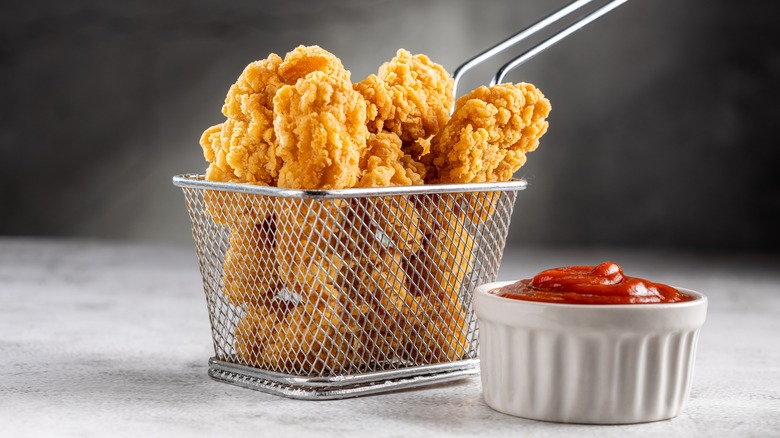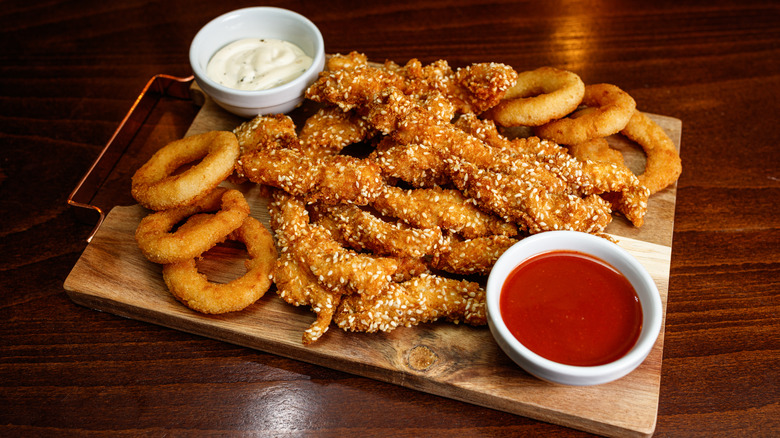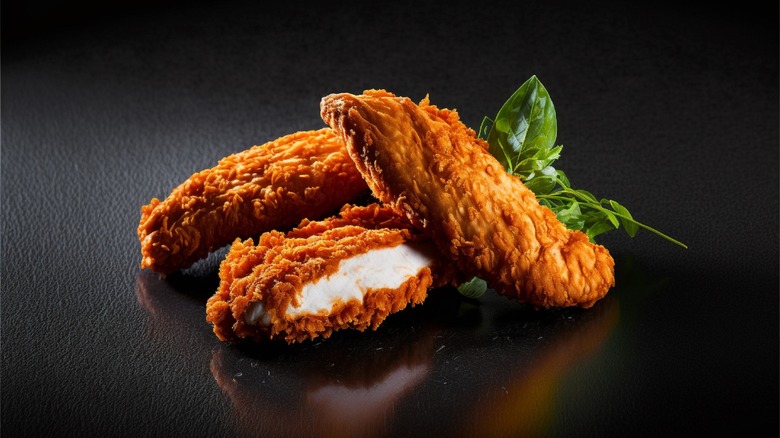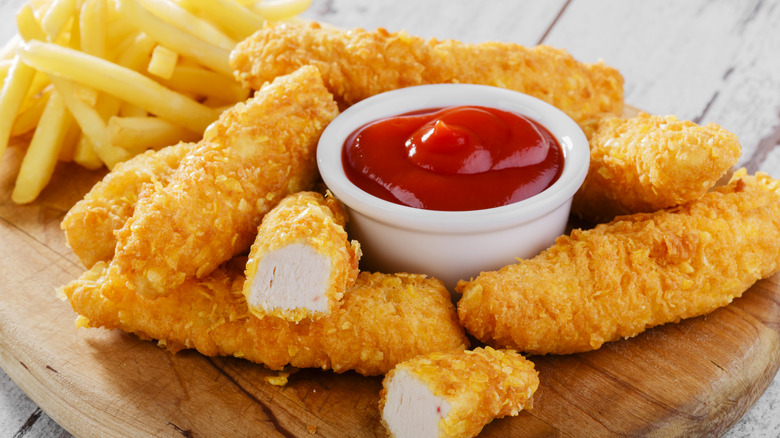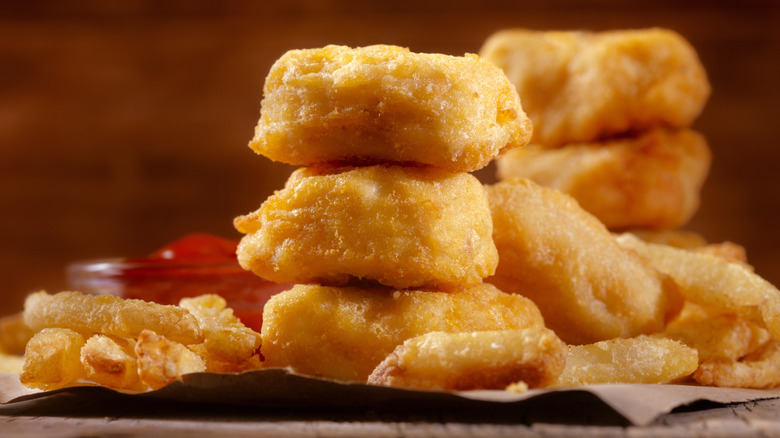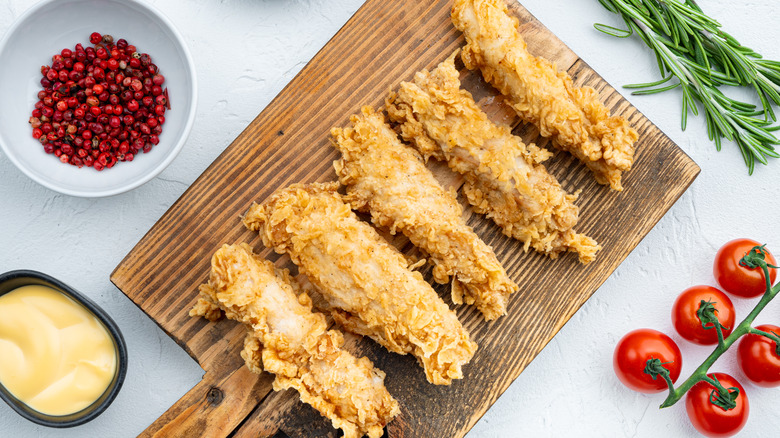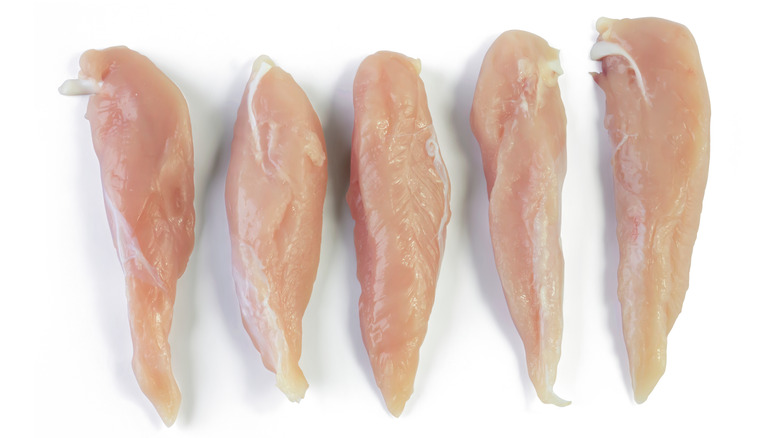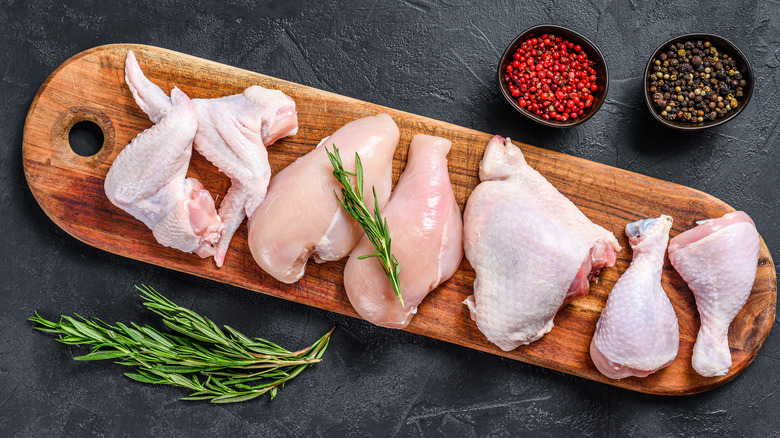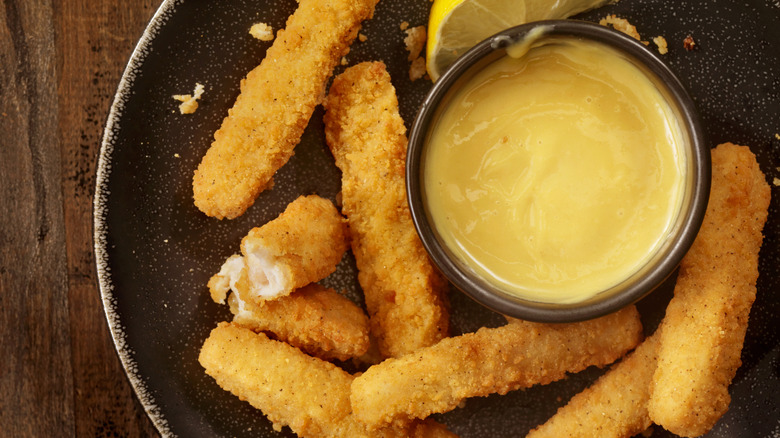Chicken Fingers Vs Tenders: What's The Difference?
In my nearly 18 years as a professional chef, one meat reigned supreme on my menu, despite its less than stellar reputation among culinary professionals: chicken. Indeed, according to Vox, chicken is the most consumed meat on the planet, with nearly 74 billion birds processed annually, enough for each of us to eat roughly nine per person, per year. And, while there are many ways to prepare this cost-effective, prolific meat, most restaurant menus will reveal that crisp, breaded, fried fingers or tenders are among the recipes that children and adults alike favor as an appetizer or quick, satisfying entrée. But what exactly are chicken fingers or tenders? And, are they actually the same thing?
These are the burning questions that I seek to answer. Though the terms fingers, tenders, and even strips are often used synonymously, there are distinctions that can, and should, be made so that you know exactly what you are buying and consuming. Read on to discover the nuances that will help you navigate the menu like a poultry expert the next time you pull up to your favorite fast-food drive-thru to order a chicken meal.
What are chicken fingers?
Before getting too deep in the weeds in discussing what a chicken finger is, it must be said that chickens do not have fingers, per se. They do have arms, in the form of a wing, that somewhat resemble those of a human, but their winglets, the equivalent of our hands, are made up of three smaller digits, all aimed at helping the bird fly, rather than grip. Fun fact: Though chickens can fly, they are only capable of doing so in spurts, going short distances. Moreover, domesticated chickens are less capable of flying because their breasts are bred to be larger, making them top heavy and preventing them from achieving lift-off. Now that we have bird anatomy out of the way, we can discuss what makes a chicken finger what it is.
At its most basic, chicken fingers are slender, elongated portions of chicken breast that are typically breaded and fried before being served alongside a delectable dipping sauce. The "finger" moniker likely stems from their shape, which resembles that of a human digit. Chicken fingers can be obtained by slicing the chicken breast vertically or can be produced using the chicken tenderloin, or tender (more on that in a bit). Chicken fingers can also be labeled chicken strips, further muddying the waters.
What are chicken tenders?
While all tenders can be called fingers or strips, not all fingers or strips can be called tenders. The tender refers to a specific muscle located below the chicken breast, known as the pectoralis minor. Every chicken has two tenderloins, making it a premium cut of meat. This cut of chicken, which spans about 5 inches in length and roughly an inch and a half in width, is punctuated by a distinct, white, string-like tendon that is perfectly harmless, though not necessarily palatable.
The tendon, or tenderloin, of a chicken can be equated to those of beef or pork. This cut is revered because it tends to be a piece of meat that gets less exercise, rendering it far more luscious and juicy when cooked. For reference, the filet mignon is obtained from the tenderloin of a cow, which may help to put the superior quality of this cut into context.
Chicken tenders can be prepared similarly to fingers or strips, breaded and fried to golden perfection, though they are also served grilled, skewered, and stir-fried. If a restaurant specifically labels a dish as "chicken tenders," you can expect to get the tenderloin of the chicken, and not a manufactured cut of meat from the breast or thigh.
What are chicken strips?
Though it can refer to the process of undressing oneself, in this case, the word "strip" refers to the long, thin shape of a piece of breaded and fried chicken. It is used interchangeably with the terms fingers or tenders. While all tenders are strips, not all strips are made from the chicken tender or tenderloin. Additionally, while they are generally formed from breast meat, there is no reason you couldn't create a recipe using chicken thighs sliced into strips for those preferring the flavor of dark meat.
Often the decision as to whether you call these dishes a finger or a strip has more to do with marketing than anything else. The fast food chain Raising Cane's, for example, went the finger route, differentiating itself from others, like Chick-fil-A, who went the strip route, trademarking the term Chick-n-Strips. However you slice them or whatever you call them, chicken strips of various iterations are big business for restaurants and fast food eateries, alike. They are also sold in ready-to-eat packages in the freezer section of most grocery stores nationwide.
What are chicken nuggets?
Another popular chicken-y food item that is compared to, but is vastly different from chicken fingers, tenders, and strips, is the nugget. This fabricated chicken product was the brainchild of Robert C. Baker, an agricultural scientist who invented novel poultry products at Cornell University in the 1960s. The invention enabled food manufacturers to use the whole chicken by converting it into manageable processed edibles that were convenient and easy to transport.
Nuggets are made from pulverized skinless chicken bits that are enveloped in a blanket of breading to make them easy to freeze and fry. Most nuggets contain meat from the chicken breast along with other parts mixed in, including nervous tissue, connective tissue, bones, tendons, and fat. These are combined with various preservatives and binders, that help give the nugget their shape and distinctive texture.
While on the topic of manufactured chicken parts, it is worth discussing the boneless chicken wing. Boneless wings are often compared with nuggets in terms of convenience and ease of consumption. That said, a majority of boneless chicken wings are not actually what they say they are. Deboning a chicken wing is a messy, time-consuming process that would be inefficient for restaurants to execute. Boneless chicken wings are generally produced from the same breast meat as nuggets, though rather than grinding the meat into a paste and forming it into a wing-like orb, the breast itself is cut into the appropriate shape before it is breaded and fried.
Chicken tenders are usually juicier than chicken fingers
As a general rule, chicken tenders are juicier and more supple than fingers sourced from breast meat, when properly cooked, though thighs are often preferred because they are more forgiving to work with and tend to stay moist at higher temperatures. To understand why this is the case, it is important to understand bird anatomy.
We already assessed that chickens do not have fingers and that they are not particularly efficient flyers. Domesticated chickens tend to ambulate on their legs. This means their legs are made up of dark meat that is rife with connective tissues that take a long time to break down when cooked. Their breasts, which do not exert much energy save for the occasional short flight, are formed from white meat that lacks much of that connective tissue. The tenderloin, located below the breast, is the least exercised part of the chicken, thereby lacking any connective tissue.
Though the USDA recommends cooking chicken meat to a safe minimum internal temperature of 165 degrees F, breast meat is notoriously easy to overcook, making it fickle to work with. For this reason, breast meat, including the tenderloin, must be monitored carefully, particularly when using higher-heat cooking applications, such as frying. All things being the same, when you properly bread and fry fingers and tenderloins, the tenderloin will inevitably come out having a more luscious mouthfeel as long as it is not overdone.
Chicken tenders typically cost more than chicken fingers
When it comes to cost, chicken prices will vary depending upon where you live, what day it is, and if you opt to purchase organic versus non-organic meat. Chicken prices go up and down weekly, though certain trends remain the same. For the most part, whole chicken and bone-in segments will cost less than boneless pieces, which makes sense when you consider the extra processing involved in deboning the meat. Additionally, dark meat is typically less expensive than white meat. Within the white meat category, tenderloins tend to cost more than whole breasts.
For this reason, many restaurants opt to use whole chicken breasts rather than tenders because they are more cost-effective. The breast yields more meat that can easily be cut into several fingers or strips, while the tender is only one portion. The breast is also more versatile in terms of preparation methods, meaning it can be used for multiple recipes, including sandwiches, which many restaurants offer in addition to breaded and fried fingers or strips.
Chicken tenders may be less nutritious than fingers
Though all chicken is a good source of lean protein and rich in nutrients, when comparing white to dark meat, the former always fares better nutritionally than the latter. According to the USDA, a 100-gram portion of boneless, skinless chicken thighs contains 144 calories, 18.6 grams of protein, 7.92 grams of fat, and 62 milligrams of sodium. The equivalent quantity of boneless, skinless chicken breasts contains 158 calories, 32.1 grams of protein, 3.24 grams of fat, and 47 milligrams of sodium.
Ironically, though tenderloins are also considered white meat, they do differ nutritionally from breast meat. A 100-gram portion of chicken tenderloins has 107 calories, 22.32 grams of protein, 1.34 grams of fat, and 80 milligrams of sodium. In terms of calories and fat, tenderloins perform better than breast meat, but they also contain markedly lower amounts of protein and almost double the amount of naturally occurring sodium.
For those seeking higher protein content that may be watching sodium levels in their food, fingers perform somewhat healthier than tenders. That said, how these are prepared can markedly impact how healthy (or not) they are. Oven-baked chicken tenders or fingers will be healthier than those that are fried, and some breading contains less fat, sodium, and fillers than others.
How to cook chicken fingers vs tenders
Ultimately, chicken tenders and fingers can be cooked similarly as their flavor is virtually identical, though tenders are also frequently used in recipes other than breaded and fried strips. That said, when making strips, there are some common mistakes to avoid, including not seasoning the meat and limiting the ingredients you use to coat your chicken. French fried onions make a flavorful coating and potato chips make chicken strips impossibly crunchy. Then there are other creative ways to take your chicken fingers and tenders to the next level, including marinating them in vodka or buttermilk and adding dried herbs to the breadcrumb mixture. Lastly, no chicken finger or tender would be complete without whipping up a batch of a delectable sauce to dip them in.
If you happen to find yourself with leftover chicken fingers or tenders, there are a number of different ways you can repurpose them. Consider using them as a topping for homemade pizza, popping them between two slices of bread for a crunchy sandwich, or wrapping them in bacon for an easy and delicious appetizer that will surely please a crowd.
